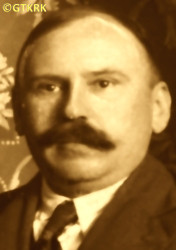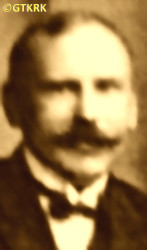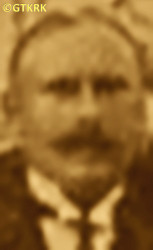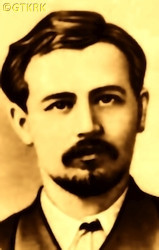Roman Catholic
St Sigismund parish
05-507 Słomczyn
85 Wiślana Str.
Konstancin deanery
Warsaw archdiocese, Poland
full list:
displayClick to display full list

searchClick to search full list by categories
wyświetlKliknij by wyświetlić pełną listę po polsku

szukajKliknij by przeszukać listę wg kategorii po polsku

Martyrology of the clergy — Poland
XX century (1914 – 1989)
personal data
surname
TELEŻYŃSKI
surname
versions/aliases
TELERZYŃSKI
forename(s)
Michael (pl. Michał)

function
presbiter (i.e. iereus)
creed
Eastern Orthodox Church ORmore on
en.wikipedia.org
[access: 2014.09.21]
diocese / province
Volyn OR eparchy (Polish Autocephalous Orthodox Church PAOC)more on
pl.wikipedia.org
[access: 2021.12.19]
nationality
Ukrainian
date and place
of death
08.05.1940

NKVD Ukrainetoday: Ukraine
more on
en.wikipedia.org
[access: 2023.03.02]
alt. dates and places
of death
NKVD KievHQ at 17 Korolyenky Str.
today: 33 Volodimirska Str., Kiev city rai., Kiev city obl., Ukraine
more on
en.wikipedia.org
[access: 2023.03.02]
NKVD KharkivHQ at 5 Sovnarkomskaya Str.
today: 5 Mirronosits Str., Kharkiv urban hrom., Kharkiv rai., Kharkiv obl., Ukraine
more on
en.wikipedia.org
[access: 2022.08.05]
Khersontoday: Kherson urban hrom., Kherson rai., Kherson obl., Ukraine
more on
en.wikipedia.org
[access: 2022.08.05]
details of death
During World War I 1914‐1918, mobilized into the Russian Imperial Army.
After the fall of tsarism in 02.1917, a member of the Ukr. Українська Центральна Рада (Eng. Ukrainian Central Council), founded on 17.03.1917 in Kiev, and later subordinated to the Ukr. Всеукраїнська Рада військових депутатів (Eng. All–Ukrainian Council of Military Deputies). After the Bolshevik coup in 11.1917 in Russia a member of Ukr. Крайовий комітет з охорони революції в Україні (Eng. National Committee for the Protection of the Revolution in Ukraine) — functioning only a few days.
After the Ukrainian Central Council announced on 22.01.1918 in Kiev the independence of Ukraine as the Ukrainian People's Republic UPR, became conductor of the Ukrainian State Choir and co–organizer of the State Symphony Orchestra. During the Russian–Ukrainian War of 1918‐1920, moved with the UPR leadership and the troops of General Simon Petlura to subsequent seats of its authorities, including to Kamyanets–Podilskyi where worked at the Ministry of Roads.
After the Ukrainian defeat, during the Polish–Russian war of 1919‐1921, moved to the territory of independent Poland. Joined the movement seeking to establish an autocephalous Ukrainian Orthodox Church in Poland. The attempt failed, and the Polish authorities, for pro–Ukrainian activities, arrested him on 01.04.1925. Nine days later was released.
In 1930‐1935 a member of the Parlament — Seym — of the Republic of Poland of the third term on behalf of the BBWR party — co‐founder of the Volyn Ukrainian Union, a political party striving for Ukrainian autonomy within the Polish state.
After German and Russian invasion of Poland in 09.1939 and start of the World War II, after start of Russian occupation, arrested by the Russians in 12.1939.
Held in Volodimir–Volynsky prison.
On 29.04.1940 brought to Kiev.
There on 08.05.1940 driven out in unknown direction and murdered by the Russians as part of the mass murder known as the «Katyn genocide».
His name is on the so‐called «Tsvetukhin's list», i.e. a report that was sent from Kiev to the 1st Special Department of the NKVD in Moscow on 25.11.1940 — one of the available lists of Poles genocidally murdered by the NKVD (known also as «Ukrainian Katyn List»). The report contains 3,435 names of people killed on the basis of one of 33 „disposition lists” — lists sent from the NKVD headquarters, based on the decisions of the Special NKVD College, i.e. the genocidal kangaroo court known as the «NKVD Troika», to the local NKVD center responsible for executions. The said report states that his name — at No. 2909 — was on the „disposition list” No. 43/2 item 62 (though „disposition list” itself has not been found).
cause of death
mass murder
perpetrators
Russians
sites and events
NKVD UkraineClick to display the description, NKVD KharkivClick to display the description, «Katyn genocide 1940»Click to display the description, Kiev (Lyukyanivska)Click to display the description, Ribbentrop‐MolotovClick to display the description, Polish‐Russian war of 1919‐1921Click to display the description, Polish‐Ukrainian war of 1918‐1919Click to display the description
date and place
of birth
26.01.1886

Bulaitoday: Pohrebyshche urban hrom., Vinnytsia rai., Vinnytsia obl., Ukraine
more on
uk.wikipedia.org
[access: 2024.02.27]
parents
TELEŻYŃSKI Theodore
🞲 ?, ? — 🕆 ?, ?

🞲 ?, ? — 🕆 ?, ?
presbyter (holy orders)
ordination
31.05.1936

positions held
1936 – 1939
parish priest — Volodymyr‐Volynskyitoday: Volodymyr, Volodymyr urban hrom., Volodymyr rai., Volyn obl., Ukraine
more on
en.wikipedia.org
[access: 2020.07.31] ⋄ St Basil the Great RC church ⋄ Volodymyr‐Volynskyitoday: Volodymyr, Volodymyr urban hrom., Volodymyr rai., Volyn obl., Ukraine
more on
en.wikipedia.org
[access: 2020.07.31] RC deanery — appointment: on 19.05.1936
31.05.1936
presbiter (Eng. priest, i.e. iereus) — Polish Autocephalous Orthodox Church PACP — priesthood cheirotonia, i.e. ordination, on 30.05.1916 preceded by deacon cheirotonia
1930 – 1935
parliamentary deputy — Seym i.e. Parliament (3rd Term), Second Polish Republic — on behalf of the Nonpartisan Bloc for Cooperation with the Government BBWR; also: secretary of the Volyn Ukrainian Union VUO political party, prob. president of the VUO district board in Kovel, member of the Lutsk Committee for the Translation of the Holy Scripture and Orthodox liturgical books into Ukrainian
from 17.12.1928
psalmist — Lutsktoday: Lutsk city rai., Volyn obl., Ukraine
more on
en.wikipedia.org
[access: 2021.09.17] ⋄ Exaltation of the Holy Cross OR church — also: c. 1929 choir director of the Brotherhood of the Holy Cross, c. 1930 School Committee inspector of Ukrainian folk choirs
till c. 1928
psalmist — Volodymyr‐Volynskyitoday: Volodymyr, Volodymyr urban hrom., Volodymyr rai., Volyn obl., Ukraine
more on
en.wikipedia.org
[access: 2020.07.31] ⋄ Dormition of the Blessed Virgin Mary OR cathedral church
c. 1920 – 04.12.1924
psalmist — Volodymyr‐Volynskyitoday: Volodymyr, Volodymyr urban hrom., Volodymyr rai., Volyn obl., Ukraine
more on
en.wikipedia.org
[access: 2020.07.31] ⋄ Dormition of the Blessed Virgin Mary OR cathedral church — fired for supporting the autocephaly of the Ukrainian Orthodox Church
1918 – 1920
employee — Ukrainian People's Republic UPR — i.a. conductor of the Ukrainian State Choir, co‐organizer of the State Symphony Orchestra, in c. 1920 employee of the Ministry of Roads in Kamyanets–Podilskyi
c. 1914 – c. 1917
soldier — Imperial Russian Army
teacher — Cherkasytoday: Cherkasy urban hrom., Cherkasy rai., Cherkasy obl., Ukraine
more on
en.wikipedia.org
[access: 2024.02.27] ⋄ songs and music, gymnasium
teacher — Kievtoday: Kiev city rai., Kiev city obl., Ukraine
more on
en.wikipedia.org
[access: 2023.03.02] ⋄ musicology, Teachers' Seminary — also: head of the „model” school at the Seminary
student — Kievtoday: Kiev city rai., Kiev city obl., Ukraine
more on
en.wikipedia.org
[access: 2023.03.02] ⋄ philosophy and theology, Orthodox Theological Seminary
till 1905
pupil — Kievtoday: Kiev city rai., Kiev city obl., Ukraine
more on
en.wikipedia.org
[access: 2023.03.02] ⋄ Theological School ⋄ Dormition of the Mother of God OR monastery (Pechersk Lavra)
married — at least one son
composer of „Liturgy” (1922), „Collection of songs and games for children” (Stanislaviv), 40 choral songs, a collection of 160 Ukrainian songs, children's operas „Saint Nicholas”, „Evening and Morning Message”, the „The Statute of Ukrainian National Choirs”, author of press articles, among others biographical essays on composers Kiril Stetsenko and Nikolai Łeontovich (1928), also: collaborator of the magazine „Ukrainian Niva”
others related
in death
BĄCZKOWSKIClick to display biography Thaddeus, MATZNERClick to display biography Stanislav Clement, TYSZKAClick to display biography Michael, NIEIZWIESTNYClick to display biography Anatol
sites and events
descriptions
NKVD Ukraine: In 04‐05.1940, the Russian genocidal NKVD organization shot in Ukraine — as part of the «Katyn genocide of 1940» — c. 3,435 people (according to some assumptions, there could have been even 4,181). This genocide was the implementation of the decision of the Russian Commie–Nazi authorities — the Politburo of the Russian Commie–Nazi party — of 05.03.1940 to exterminate tens of thousands of Polish intelligentsia and military personnel held in Russian camps established after the German–Russian Ribbentrop–Molotov Agreement and the annexation of half of Poland by the Russians in 1939. After the formal „verdict”, the NKVD Special Council, i.e. genocidal Russian kangaroo court known as «NKVD Troika», in Moscow sent 33 disposition letters to the NKVD in Ukraine, containing the names of people to be murdered. In order to implement it, the head of the NKVD, Lavrentiy Beria, issued on 22.03.1940 order No. 00350 on the „unloading of NKVD prisons”, ordering the transport of prisoners from Lviv, Rivne, Ternopil, Drohobych, Stanislaviv and from the „Volyn” prison to prisons in Kiev, Kharkov and Kherson. There is a known list of 3,435 personal files of executed Polish citizens — sent on 25.11.1940 by the NKVD of Ukraine to the 1st Special Department of the NKVD in Moscow (personally to Leonid Bashtakov, one of the «NKVD Troika» members) — known as the «Ukrainian Katyn List» or «Tsvetukhin's list». It contains names of 726 officers of the Polish Army (including 7 generals), 770 officers of the State Police, 28 officers of the Prison Guard. The rest are civilians. It is not known where they were murdered or where they are buried. An unknown number were held in Lyukyanivska prison in Kiev, and then murdered in the building at 17 Korolyenky Str. (today 33 Volodimirska Str.), the Ukrainian headquarters of the NKVD. The bodies were probably buried in the forest, in Bykivnya near Kiev. Some of the victims were prob. murdered in the NKVD headquarters in Kharkiv, where Polish officers from the KLW Starobilsk concentration camp were also executed. It is not known whether and where they were killed in Kherson. The victims were murdered in soundproof basements, one by one, by the so‐called Katyn method, with a pistol shot to the back of the head. (more on: pl.wikipedia.orgClick to attempt to display webpage
[access: 2013.08.10], pl.wikipedia.orgClick to attempt to display webpage
[access: 2013.08.10])
NKVD Kharkiv: On 05.04‐12.05.1940 Russians executed in NKVD headquarters at 5 Sovnarkomskaya Str. (today 5 Mirronosits Str.) in Kharkiv c. 3,739 Polish prisoners of war (POW) kept in KLW Starobilsk concentration camp in Starobilsk. This genocide was the implementation of the decision of the Russian Commie‐Nazi authorities — the Politburo of the Russian Commie‐Nazi party — of 05.03.1940 to exterminate tens of thousands of Polish intelligentsia and servicemen, held in Russian camps established after the German‐Russian Ribbentrop‐Molotov Agreement and the annexation of half of Poland by the Russians in 1939, known as «Katyn genocide». After the formal „verdict”, the NKVD Special Council Moscow, i.e. the genocidal Russian kangaroo court known as the «NKVD Troika», sent successive disposition letters to the NKVD in Kharkiv — there were c. 36 of them — containing the names of the persons to be murdered. The murders were committed in the NKVD District Directorate HQ, at 3 Dzerzhinsky Sq. Convoys of prisoners were transported by rail to the Kharkov railway station, and from there by car to the NKVD headquarters. The victims' hands were tied behind their backs with a rope and at night they were taken to a windowless room in the basement. There, they were murdered with a shot in the neck from a 7.62 mm Nagant revolver. Immediately afterwards, the bodies were taken away in trucks and buried in mass graves near Kharkov, 1.5 km from the village of Piatykhatky. Prob. also later, till 06.1940, an unknown number of Poles from the so–called «Ukrainian Katyn List» or «Tsvetukhin's list» were murdered there in the same way. (more on: en.wikipedia.orgClick to attempt to display webpage
[access: 2014.09.21])
«Katyn genocide 1940»: 05.03.1940, the Russian Commie‐Nazi authorities — the Politburo of the Russian Commie‐Nazi party headed by Joseph Stalin — made a formal, secret decision No. P13/144 to exterminate tens of thousands of Polish intelligentsia and military personnel, „declared and hopeless enemies of the Russian government”, held in Russian camps, as a consequence of the German‐Russian Ribbentrop‐Molotov Agreement, the invasion of Poland and annexation of half of Poland in 09.1939, and the beginning of World War II. The decision was, as it were, „sanctioned” by the verdicts of the NKVD Special Council, i.e. the genocidal Russian kangaroo court known as «NKVD Troika» in Moscow. The implementation in Ukraine and Belarus was made possible by order No. 00350 of 22.03.1940 of the head of the NKVD, Lavrentiy Beria, on the „unloading of NKVD prisons”, i.e. transfer of prisoners from several prisons in Ukraine and Belarus to central prisons, e.g. in Kiev or Minsk. The genocidal «NKVD Troika», after issuing sentences, also sent to local NKVD units, NKVD disposition lists — i.e. lists of convicts — each containing on average c. 100 names. Named lists are known — may be reconstructed — for people held in the KLW Kozelsk and KLW Ostashkov camps, but not for KLW Starobilsk, known for victims from Ukrainian prisons, but not Belarusian ones. It is not even known exactly how many lists there were, mainly because the number of them sent to the NKVD in Belarus is unknown. On 03.03.1959 Alexander Shelepin, then head of the Russian KGB, in a handwritten note stated: „ Since 1940, the Committee for State Security under the Council of Ministers of Russia, has been keeping records and other materials relating to the prisoners of war and interned officers, gendarmes, policemen, etc., people from former bourgeois Poland shot that year. In total, based on the decision of the special troika of the NKVD of the USSR, 21,857 people were shot, of whom: 4,421 people in the Katyn Forest (Smolensk Oblast), 3,820 people from the Starobilsk camp near Kharkov, 6,311 people from the Ostashkov camp (Kalinin Oblast), and 7,305 people in other camps and prisons in Western Ukraine and Western Belarus. The entire operation of liquidation of the above–mentioned was carried out on the basis of the Resolution of the Central Committee of the CPSU of 05.03.1940”. The head of the NKVD recommended to the Russian leader, Nikita Khrushchev, to destroy all personal files of those shot in 1940, but to keep the minutes of the meetings of the «NKVD Troika» and confirmations of the implementation of the decisions of the «NKVD Troika». A one–sentence draft resolution was attached to the note. It is not known whether the resolution was accepted and whether the files were destroyed. The aforementioned protocols and confirmations of the «NKVD Troika» are also not known. There are indications — i.e. four so‐called „NKVD‐Gestapo Methodical Conferences” of 1939‐1940: in Brest on Bug, Przemyśl, Zakopane and Cracow — of close collaboration between Germans and Russians in realization of plans of total extermination of Polish nation, its elites in particular — decision that prob. was confirmed during meeting of socialist leaders of Germany: Mr Heinrich Himmler, and Russia: Mr Lavrentyi Beria, in another German leader, Mr Hermann Göring, hunting lodge in Rominty in Romincka Forest in East Prussia. (more on: en.wikipedia.orgClick to attempt to display webpage
[access: 2023.12.15])
Kiev (Lyukyanivska): Russian political prison in Kiev, in the first half of 20th century run by the genocidal NKVD, informally referred to as prison No 1, formally as Investigative Prison No 13 (SIZO#13). It was founded in the early 19th century. In the 20th century, during the Soviet times, the prison church was transformed into another block of cells. During the reign of J. Stalin in Russia, more than 25,000 prisoners passed through it. (more on: en.wikipedia.orgClick to attempt to display webpage
[access: 2014.09.21])
Ribbentrop‐Molotov: Genocidal Russian‐German alliance pact between Russian leader Joseph Stalin and German leader Adolf Hitler signed on 23.08.1939 in Moscow by respective foreign ministers, Mr. Vyacheslav Molotov for Russia and Joachim von Ribbentrop for Germany. The pact sanctioned and was the direct cause of joint Russian and German invasion of Poland and the outbreak of the World War II in 09.1939. In a political sense, the pact was an attempt to restore the status quo ante before 1914, with one exception, namely the „commercial” exchange of the so‐called „Kingdom of Poland”, which in 1914 was part of the Russian Empire, fore Eastern Galicia (today's western Ukraine), in 1914 belonging to the Austro‐Hungarian Empire. Galicia, including Lviv, was to be taken over by the Russians, the „Kingdom of Poland” — under the name of the General Governorate — Germany. The resultant „war was one of the greatest calamities and dramas of humanity in history, for two atheistic and anti‐Christian ideologies — national and international socialism — rejected God and His fifth Decalogue commandment: Thou shall not kill!” (Abp Stanislav Gądecki, 01.09.2019). The decisions taken — backed up by the betrayal of the formal allies of Poland, France and Germany, which on 12.09.1939, at a joint conference in Abbeville, decided not to provide aid to attacked Poland and not to take military action against Germany (a clear breach of treaty obligations with Poland) — were on 28.09.1939 slightly altered and made more precise when a treaty on „German‐Russian boundaries and friendship” was agreed by the same murderous signatories. One of its findings was establishment of spheres of influence in Central and Eastern Europe and in consequence IV partition of Poland. In one of its secret annexes agreed, that: „the Signatories will not tolerate on its respective territories any Polish propaganda that affects the territory of the other Side. On their respective territories they will suppress all such propaganda and inform each other of the measures taken to accomplish it”. The agreements resulted in a series of meeting between two genocidal organization representing both sides — German Gestapo and Russian NKVD when coordination of efforts to exterminate Polish intelligentsia and Polish leading classes (in Germany called «Intelligenzaktion», in Russia took the form of Katyń massacres) where discussed. Resulted in deaths of hundreds of thousands of Polish intelligentsia, including thousands of priests presented here, and tens of millions of ordinary people,. The results of this Russian‐German pact lasted till 1989 and are still in evidence even today. (more on: en.wikipedia.orgClick to attempt to display webpage
[access: 2015.09.30])
Polish‐Russian war of 1919‐1921: War for independence of Poland and its borders. Poland regained independence in 1918 but had to fight for its borders with former imperial powers, in particular Russia. Russia planned to incite Bolshevik‐like revolutions in the Western Europe and thus invaded Poland. Russian invaders were defeated in 08.1920 in a battle called Warsaw battle („Vistula river miracle”, one of the 10 most important battles in history, according to some historians). Thanks to this victory Poland recaptured part of the lands lost during partitions of Poland in XVIII century, and Europe was saved from the genocidal Communism. (more on: en.wikipedia.orgClick to attempt to display webpage
[access: 2014.12.20])
Polish‐Ukrainian war of 1918‐1919: One of the wars for borders of the newly reborn Poland. At the end of 1918 on the former Austro‐Hungarian empire’s territory, based on the Ukrainian military units of the former Austro‐Hungarian army, Ukrainians waged war against Poland. In particular attempted to create foundation of an independent state and attacked Lviv. Thanks to heroic stance of Lviv inhabitants, in particular young generation of Poles — called since then Lviv eaglets — the city was recaptured by Poles and for a number of months successfully defended against furious Ukrainian attacks. In 1919 Poland — its newly created army — pushed Ukrainian forces far to the east and south, regaining control over its territory. (more on: en.wikipedia.orgClick to attempt to display webpage
[access: 2017.05.20])
sources
personal:
www.aspektpolski.comClick to attempt to display webpage
[access: 2019.10.13], mistovechirne.in.uaClick to attempt to display webpage
[access: 2024.02.27], parafia.org.uaClick to attempt to display webpage
[access: 2024.02.27], www.katyn-pamietam.plClick to attempt to display webpage
[access: 2019.10.13]
bibliographical:
„Hierachy, clergy and employees of the Orthodox Church in the 19th‐21st centuries within the borders of the Second Polish Republic and post–war Poland”, Fr Gregory Sosna, M. Antonine Troc-Sosna, Warsaw–Bielsk Podlaski 2017
original images:
audiovis.nac.gov.plClick to attempt to display webpage
[access: 2019.10.13], www.facebook.comClick to attempt to display webpage
[access: 2024.02.27], www.starodavnij-volodymyr.com.uaClick to attempt to display webpage
[access: 2024.02.27], www.volodymyrmedia.com.uaClick to attempt to display webpage
[access: 2024.02.27]
LETTER to CUSTODIAN/ADMINISTRATOR
If you have an Email client on your communicator/computer — such as Mozilla Thunderbird, Windows Mail or Microsoft Outlook, described at WikipediaPatrz:
en.wikipedia.org, among others — try the link below, please:
LETTER to CUSTODIAN/ADMINISTRATORClick and try to call your own Email client
If however you do not run such a client or the above link is not active please send an email to the Custodian/Administrator using your account — in your customary email/correspondence engine — at the following address:

giving the following as the subject:
MARTYROLOGY: TELEŻYŃSKI Michael
To return to the biography press below:
 Click to return to biography
Click to return to biography











